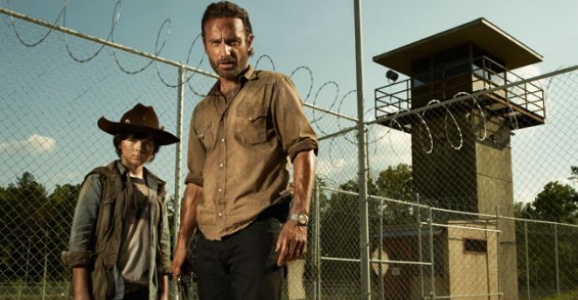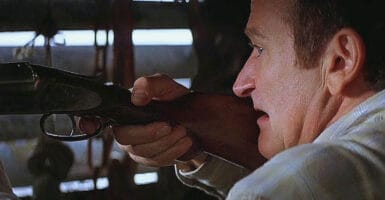The Walking Dead: Season Four Report Card
This article is more than 2 years old
 Now that AMC’s hit zombie drama The Walking Dead has shuffled off for another end-of-the-year hiatus full of casting updates and random fan speculation, we have some space to take a step back and examine the season that was. Going into season four, I was hopeful, despite the fact that, since nearly day one, I’ve had a troubled, at best, relationship with this show. Season three saw one of the best episodes of the series (“Clear”), and some of the absolute worst (“Arrow on the Doorpost,” among others). Plagued since the beginning by a lack of overall consistency, season three raised fluctuations in quality to a damn art form.
Now that AMC’s hit zombie drama The Walking Dead has shuffled off for another end-of-the-year hiatus full of casting updates and random fan speculation, we have some space to take a step back and examine the season that was. Going into season four, I was hopeful, despite the fact that, since nearly day one, I’ve had a troubled, at best, relationship with this show. Season three saw one of the best episodes of the series (“Clear”), and some of the absolute worst (“Arrow on the Doorpost,” among others). Plagued since the beginning by a lack of overall consistency, season three raised fluctuations in quality to a damn art form.
Here’s why, armed with a new showrunner, the third in the show’s short life, I still had hope. See, the new head, taking over after Glen Mazzara was unceremoniously—and publicly—ousted, is Scott M. Gimple, who, as a writer, is responsible for the best and most memorable episodes of the entire run. And low and behold, my persistence paid off, and season four is indeed the most consistent in Walking Dead history. The season is definitely a tale of two halves, bisected as it was by their annual mid-season break, but even approaching it in this manner, there was almost nothing but forward progress.
Thematically, stylistically, and structurally, the first half of season four is very much a continuation of season three. You get the definite feeling that these episodes are the new regime dealing with old business, cleaning up the mess that was left to them. But even then, there is momentum despite dealing with preexisting conditions and issues.
The action picks up a few months after the end of season three. Andrea is still dead, the Governor (David Morrissey) is still out there, and people are bummed, but they’ve managed to turn the prison into something that resembles a home. Their numbers have grown as they took in refugees from Woodbury and come across other survivors. Rick (Andrew Lincoln) has pushed Carl (Chandler Riggs) into a more domestic role and now he’s a little farmer; Glenn (Steven Yeun) and Maggie (Lauren Cohan) are still doing it every chance they get; and Carol (Melissa McBride) has story time with the kids, which doubles as her clandestine lessons showing them how to use weapons to defend themselves. Michonne (Danai Gurira) still goes out on missions looking for the Governor, but he’s seemingly vanished into the wilderness.
Overall, things just sort of chug along at a nice, even pace. This sounds rather mediocre, and while it is definitely that, it is still better than what came before. There are some questionable story choices, a huge amount of tedious, soap opera style interpersonal relationship drama, and any new addition to the cast is little more than faceless zombie food. Still, from week to week, the episodes are the most even and consistent they’ve ever been. Even though the progress is relatively minor, there is still progress each week; you no longer feel like there are entire episodes that are just a waste. That alone is a significant improvement.
This isn’t to say there is no wasted time, there certainly is. The plague storyline that they introduce gets tedious very, very quickly, and you get the impression that the writers are filling time, though none of the episodes are nearly as empty as many from season three. Again, we’re talking about baby steps, but they are in fact steps forward. But the focus is more on the people instead of just the zombies and the crazy shit, and they’re taking pains to actually attempt to develop the characters and propel the narrative.
What comes next, however, represents The Walking Dead’s biggest stumble of season four. They just had to bring the Governor back. Fans of Robert Kirkman’s comics know just how great a villain this character could have been. The show never reproduced that, hemming and hawing as they did, always trying to humanize him, never fully deciding whether they wanted him to be good, but tormented, man, or a raging monster. That indecision is a large part of why season three sucks so incredibly bad.
And not only did the writers bring the Governor back, they gave him two consecutive weeks all to himself, picking up his adventures after the fall of Woodbury. In a story arc that attempts to recreate the events of Kirkman’s novel The Rise of the Governor—which all happens before Woodbury, not after—he encounters a family, takes up with them, falls in love, and immediately falls back into that wishy-washy, is he good/is he bad back and forth. You spent an entire season watching this, and it is beyond frustrating to be right back there again.
These are the first episodes that are truly, entirely squandered. You have no emotional investment, you don’t particularly care if he’s changed or not, and they’re difficult to make it through, especially the second. But unfortunately they’re necessary. Again, the first half of the season consists of the writing staff cleaning up the mess made before them. Awkward and misplaced as it may be, the Governor storyline does set up the violent clash at the prison that ends the first half of season four.
Pages [ 1 2 ]












